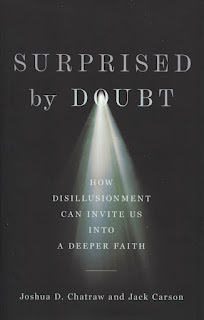Review of Surprised by Doubt: How Disillusionment can Invite us to Deeper Faith, by Chatraw and Carson
Surprised by Doubt: How Disillusionment can Invite us to Deeper Faith
This is a reallygood book. It has several problems, which I’ll discuss last, but ifyou just skim book reviews, I want to make my point early on: this isindeed a good book and can be used effectively with those wrestlingwith doubt.

As you mightguess, the title is a take-off on C. S. Lewis’s Surprised byJoy. The similarities rise to more than just the title. Theauthors quote Lewis frequently as they make their case for genuineChristianity. Their writing style is warm and not overlyacademic—also like Lewis’s. On balance the book is an invitationto carefully rethink the issues that have provoked many modernstoward skepticism, or even outright rejection, of the claims of theChristian faith.
One thing thatadds to their credibility is that the authors themselves havestruggled with doubts about their own faith. Another is that theyhonor questions and doubt without dismissing or belittling theskeptic. Instead, they engage with the doubts. Another is theirhumility: they freely admit they don’t have answers for all of thequestions. Carson and Chatraw make a case for mystery—thatunanswerable mystery should be expected when investigating asovereign God.
I’m thankfulthat they are going after base hits, not home runs—they admitrepeatedly that they cannot prove the existence of God or the claimsof the faith. Instead they are building a “wager” that theChristian explanation of reality is far more likely than alternativeexplanations.
The principalmetaphor they employ for the Christian faith is that of a great housewith many rooms, each representing a different flavor of historic,orthodox Christianity. Chatraw and Carson divide the book into threesections: The Attic, Outside the House, and The Main Floor. The roomson the main floor all share the same load-bearing walls. Theload-bearing walls represent the unifying commonality of theessentials of the orthodox faith. In other words, while each roommight differ on peripheral issues, if you’re on the main floor, youare a legitimate, true Christian.
In Part 1, thefirst five chapters of the book, Chatraw and Carson flesh out themetaphor, saying that some people have moved up to the attic anderected new walls consisting of peripheral issues that the atticdwellers insist are load-bearing. These individuals tend to say, “ifyou don’t have the same walls I do, you’re not really aChristian.” Like most attics, the ceiling is not high, and theseChristians have adopted a stooped posture, unable to stand upstraight. That stooped posture skews how they see others and how theyread the Bible.
The authorsprovide several examples of attic dwellers. Evangelicalism on theleft, with its nouveau catechisms of social justice and sexual/genderdoctrines gets a mention. Fundamentalism on the right, with its dogmaspecifying the approved positions on culture (politics and politicalparties, forms of entertainment, use of alcohol and tobacco) ortheology (eschatology, position on modern Israel, the ordinances,church governance), occupies a large part of the authors’ concerns.Some churches and fellowships (right and left) become vitriolic intheir insistence that all true believers must share their particulardistinctives.
The authors’chief concern in the book is for believers who grew up in an “atticchurch” and have reached a point of disillusionment in which theyare ready to jettison the faith because they see these questionableand peripheral issues being confidently elevated as though they areessentials alongside the actual Gospel.
In Part 2,chapters six through nine, Chatraw and Carson encourage the reader toexamine closely the ground outside the house before jumping out ofthe Attic window (the metaphor is escape, not suicide). Fouralternate philosophies are explored: the New Atheism, OptimisticSkepticism, Open Spirituality, and Mythic Truth. Chatraw and Carsondrive the presumptions attached to each of these secular philosophiesto their logical conclusions, demonstrating that the ground outsidethe house is not quite as inviting as it might first appear. Jumpingout the Attic window simply trades one set of problems for an evenworse set.
In Part 3,chapters ten through sixteen, Chatraw and Carson invite the readerto come down to the main floor and have a look around. “Now, as weturn to explore the main floor of the Christian house, we are askinga different question: Does Christianity offer a better foundation,better explanatory power, and a better way to live than the [outside]spaces we explored in part 2” [93]? They employ three perspectives:C. S. Lewis’s device of “Looking at” and “Looking Through,”to which they add “Stepping In.”
“Looking at”is a serious exploration of the historical evidences of theresurrection in chapter ten. What explanation provides the bestunderstanding of the claim that Jesus was raised from the dead:Fraud? Hallucinations? Chatraw and Carson provide multiple reasonswhy the claims of Jesus’ resurrection are best explained by Hisactual, historic, physical resurrection.
Next, in chaptereleven, the reader is asked to look at the Person in the Center—JesusHimself. Are the four gospels credible? Did they misrepresent Jesus?What kind of man was He? The authors point out that the gospelspresent Jesus as one who challenged and scandalized the orthodoxiesof His day, rather than one whose ministry was calculated to win wideapproval.
In chaptertwelve, we are invited to examine the load-bearing walls that areabsolutely essential to the integrity of the house over all. “Thisbrings us to the load-bearing walls of the Christian faith. AtticChristianity mistakenly makes the house appear as though most of itswalls are load-bearing or at least integrally attached to theload-bearing walls” [113]. The authors’ answer is to step backand look at the historic creeds which have stood the test of timeover the centuries, such as the Apostles’ Creed. The Apostles’Creed has been accepted by the Church at large as a legitimatestatement of faith for at least fifteen hundred years by believers indifferent faith streams of Christianity. It provides common groundfor the Christian faith.
Moving to themotif of “looking through,” in chapter thirteen the authorsexplore Pascal’s critique of Descartes’ skeptical approach toknowledge. In Pascal’s view, the human appreciation of and desirefor transcendent truth, beauty, and goodness is itself an argumentfor God. Pascal’s “wager” is to “take all of the aspects ofhuman behavior into account, and ask this question: Where might truejoy be found” [131]?
Chapter fourteensuggests that justice, human dignity, beauty, and meaning are allmarkers “gesturing toward a profound and mysterious meaning”[140]. In the authors’ words, “Christianity provides a windowthat makes sense of the world, including human nature and our deepestaspirations” [134]
The thirdperspective, “Stepping in,” occupies chapters fifteen andsixteen. Chatraw and Carson suggest that the skeptic “try”Christianity. “If you’d like to believe in Christianity, butdon’t think you can, you might be going about things the wrong way.It could be that you have been trying to control contingencies inorder to achieve a certain kind of certainty, your own two-plus-twoapproach to the God question” [147]. They provide three reasons forstaying on the “main floor” rather than bolting through thewindow:
There are good reasons to take the core claims of Christianity seriously [149];
What other options do you have [149]?
Since we can’t opt out of formative practices altogether, the question becomes which practices best form us for flourishing [151].
The chapter endswith this hopeful sentence: “But the collective witness of hispeople and the Scriptures is that those who humbly continue to seekGod will eventually find him” [153]. Chapter sixteen suggests thespiritual practices the seeking skeptic should engage in: participatein the sacred by observing birth, death, and marriage; commit to aroom on the main floor of the house that is serious about worship;slow down and pray; meditate on Scripture; slow down to appreciatethe beauty of creation; and continue to look both at and along thefaith.
Though I believeSurprised by Doubt is a helpful book to give someone who isconsidering “deconverting” from the faith because ofdisillusionment, I do have several concerns. For one, the authorsdon’t consider the matter of recent creation to be one of theload-bearing walls of the faith. It is presented as a (losing)argument with science that contributes to the disillusionment ofdoubting believers. But the doctrine of creation refuses to playnice. Once you give ground on recent creation by accepting somecombination of theistic evolution or old-earth theories, you’vestarted pulling on a thread integrally connected to nearly everymajor doctrine of Scripture. Besides, “science” is not speakingwith a unified voice on evolution and long ages: genuine empiricalscience is calling into question major assumptions made byevolutionists. “Received truth” like James Hutton’s principleof uniformitarianism, the bedrock of evolutionary geology, is beingseriously challenged (even by secular geologists). Andrew Snelling’smagisterial work Earth's Catastrophic Past Geology, Creation andthe Flood (two volumes) documents the modern scientificdiscoveries that dispute doctrinaire evolutionism. Is the doctrine ofrecent creation a load-bearing wall of the Gospel? Perhaps not, butthe loss of the doctrine throws a great deal of historic orthodoxyinto difficulty. Just like the authors were courageous to drive thefour secular philosophies to their logical conclusions, it might bewise for them to do the same thing if one jettisons recent creation:the resulting theological problems are daunting.
Like C. S.Lewis, Chatraw and Carson also admit to the possibility ofuniversalism, as though the doctrine of eternal judgment is anon-load-bearing wall. Despite the authors’ loyalty to historicorthodoxy, apparently that’s a historic doctrine they have chosento overlook.
My final concernhas to do with their closing advice—engage in spiritualdisciplines. For readers who are genuinely regenerated but arestruggling with doubts, that is precisely the right advice. Theirre-immersion into spiritual disciplines will eventually have itsintended effect. But for readers who are disillusioned becausethey’ve never truly been regenerated (in other words, to whom 1John 2:19 applies), Chatraw’s and Carson’s advice sounds likepreparationism—a highly disputed practice in orthodox circles. Intheir own words: “Without claiming a mechanistic and universaldemonstration of the truth of Christianity through these practices,in this chapter we’ve been inviting you to wager on Christianity bydeveloping habits that allow you to step into its light. If there isa God and Christianity is true, these practices are some of the meansof experiencing his grace” [160].
These problemsaside, I think this book can be greatly used of God for people whoare wrestling with doubts. The authors’ gentle tone and style, thefocus on the essentials, the easily understood metaphor, and theexcellent reasoning combine to make this a useful book. Four stars,highly recommended.
 newest »
newest »





Have a Merry Christmas Chris
Blessings in Christ
Mike